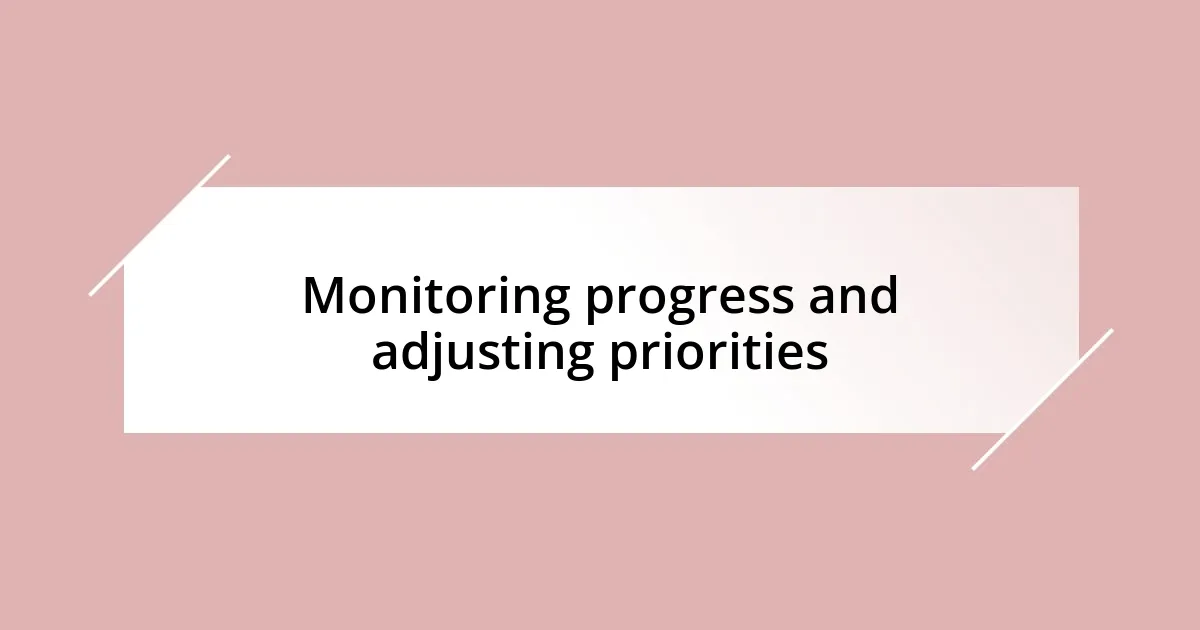Key takeaways:
- Understanding mental health priorities involves recognizing the importance of self-care and meaningful activities that enhance well-being.
- Identifying personal mental health needs through reflection and mindfulness practices helps create actionable steps for improvement.
- Setting realistic and flexible mental health goals fosters personal growth and reduces feelings of overwhelm.
- Monitoring progress and periodically reassessing priorities ensures mental health remains a focus amidst life’s demands.

Understanding mental health priorities
Understanding mental health priorities requires a deep dive into what truly matters to us individually. I remember sitting on my couch, overwhelmed by life’s demands, and realizing that my mental health often took a backseat. It made me question—how often do we push our well-being aside for the sake of obligations?
When I finally began to unravel my mental health priorities, I discovered that self-care isn’t just a luxury—it’s a necessity. I used to believe that I needed to constantly be productive to feel worthwhile, but through reflection, I found that my worth is inherent and not tied to endless tasks. Have you ever paused to consider what makes you feel truly balanced and grounded?
Revisiting my mental health priorities helped me identify the activities and relationships that nourish my spirit. I started to dedicate time each week to hobbies that bring me joy—like painting and reading—only to realize how revitalized I felt afterward. It’s fascinating how prioritizing what uplifts us can profoundly impact our overall mental well-being, isn’t it?

Identifying personal mental health needs
Identifying personal mental health needs is an introspective journey, one that requires honest self-assessment. I remember a time when I neglected my emotional cues, thinking they were merely signs of weakness. However, I learned that acknowledging my feelings—be it anxiety, sadness, or even joy—was crucial in understanding what I truly needed. Reflecting on these emotions provided clarity and revealed areas of my life that required nurturing.
I found it beneficial to list down my mental health needs, similar to creating a personal mission statement. It included factors like social interaction, creative outlets, and physical activity. This process reminded me of a time when I felt isolated, and prioritizing connections helped bridge that gap. Have you ever experienced that sense of loneliness? When I reached out to friends and made plans, it was like a breath of fresh air. Writing down my needs made them tangible and actionable, sparking motivation to incorporate positive changes into my life.
A better understanding of my personal mental health needs also came from engaging in mindfulness practices. Elements like journaling and meditation became pivotal for me, offering moments to sit with my thoughts and assess what was truly important. On days when my mind felt chaotic, I would take a moment to breathe deeply and reflect—what do I need right now? This simple practice often led me to actionable insights that not only improved my mental state but also fostered resilience against daily stressors.
| Mental Health Needs | Personal Experience |
|---|---|
| Social Interaction | Connecting with friends revitalized my spirit and reduced feelings of isolation. |
| Creative Outlets | Engaging in art provided a therapeutic escape and boosted my mood significantly. |
| Physical Activity | Incorporating walks into my routine helped clear my mind and improve my overall well-being. |
| Mindfulness | Practicing meditation led to better self-awareness and clarity in identifying my emotional needs. |

Evaluating past mental health routines
Reflecting on my past mental health routines brought up a mix of nostalgia and realization. I recall days when I followed strict schedules, believing that structure was the key to well-being. But over time, I noticed that an overly rigid routine often left me feeling suffocated rather than supported. It made me rethink how I approach mental health—sometimes, flexibility is just as vital as discipline.
- Regular meditation often felt like another task on my to-do list, rather than a source of relaxation.
- I used to avoid social activities, thinking they drained my energy, yet those connections were what I craved for balance.
- Exercise was sporadic; I’d push myself to go for runs but often ended up feeling more stressed rather than rejuvenated.
- My journaling practice was inconsistent, and I realized that writing only when I felt burdened left little room for celebration of positive moments.
This evaluation opened my eyes to the need for routines that resonate with me and bring joy, rather than merely filling time. I now prioritize spontaneity in my day, allowing for moments where I can breathe and be present without a ticking clock.

Setting realistic mental health goals
Setting realistic mental health goals requires a blend of self-awareness and practicality. A few years back, I set ambitious goals like daily meditation and exercise for an hour, only to feel defeated when I struggled to keep up. By scaling these objectives down to just five minutes of meditation and a short walk, I felt more accomplished and encouraged to build on those small victories. Have you ever felt overwhelmed by lofty expectations? Sometimes, starting small can lead to unexpected progress.
It’s essential to frame goals in a way that celebrates personal growth. For example, instead of labeling my commitment to journaling as “every day,” I shifted to “whenever I feel inspired.” This approach emphasized quality over quantity, allowing me to enjoy the process rather than viewing it as yet another obligation. I recall one evening when I wrote just a few lines about my day, and it turned into a two-hour creative outlet I hadn’t anticipated. What if you allowed yourself that same freedom?
Additionally, incorporating flexibility into my goal-setting has been a game-changer. When I aim to connect with friends, I now focus on the intention rather than a strict schedule. Some days, a text message suffices if I’m feeling introverted, while others might call for a longer meetup. This newfound balance not only reduced my anxiety but also enriched my relationships. Have you tried adjusting your goals to fit your current mental state? It could lead to a healthier, more enjoyable approach to your well-being.

Implementing positive mental health strategies
Implementing positive mental health strategies has transformed my daily life. One key strategy for me has been embracing mindfulness in simple ways. For instance, during my morning coffee, I take a moment to savor the aroma and taste, grounding myself before the day begins. Have you ever noticed how something as trivial as a cup of coffee can become a mindful ritual? This small act of presence helps me start the day on a high note, and it’s one I’ve learned to cherish.
Another approach I’ve found effective is integrating movement into my routine—especially when I don’t feel like working out. Instead of forcing myself through a gym session, I might dance around the kitchen while cooking dinner or take a leisurely walk in nature. This shift in mindset has made a world of difference; I’ve realized that movement, in any form, is a celebration of what my body can do rather than a punishment. Don’t you think it’s liberating to find joy in everyday activities?
Lastly, seeking social connections has become a vital part of my life. I’ve learned to prioritize calls or coffee dates with friends, recognizing that these interactions significantly boost my mood. One evening, after a long week, I met a friend for a casual catch-up over tea. I returned home feeling lighter and filled with laughter—a reminder of the warmth that comes from shared moments. Have you considered how essential those little gatherings can be in nurturing your mental health? Embracing these connections has reminded me that we’re all in this together.

Monitoring progress and adjusting priorities
Monitoring my mental health progress has been an enlightening journey, often requiring me to pause and reflect on my priorities. I learned early on that keeping a journal helped track my emotional state and how well I was adhering to my goals. On one particular Sunday, I noticed I felt overwhelmed and generally low despite my weekly progress. This realization prompted me to reassess my priorities, leading me to focus on self-care activities that genuinely uplifted my spirit rather than just ticking boxes.
I also discovered that adjusting my priorities isn’t a one-time effort, but rather a continuous process. During a particularly demanding period at work, I felt the urge to put my well-being on the back burner. However, I quickly recognized that my mental health needed to remain a priority, so I shifted my focus to incorporating lighter activities, like a quick evening stroll, which provided an essential reset. Have you ever found yourself needing to recalibrate your approach to self-care? It’s all about listening to your needs and adjusting your strategies when life throws you a curveball.
Reflecting on my journey, I’ve realized that setting periodic check-ins with myself can be hugely beneficial. Each week, I take a moment to look back and evaluate my successes and setbacks. Just the other day, I saw that my meditation practice had dipped, and instead of feeling defeated, I allowed myself to explore why. Perhaps it was just a busy period, or maybe I needed a different technique to keep it engaging. This process of monitoring allows me to stay honest with myself and ensures that my priorities are aligned with my current mental health needs. Have you tried creating your own check-in routine? It might just provide the clarity you need to reorient your path.














